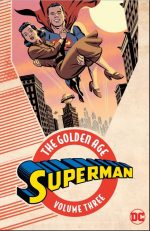

By Jerry Siegel & Joe Shuster, Wayne Boring, Jack Burnley, Paul Cassidy, Ed Dobrotka, Don Komisarow, Leo Nowak, Fred Ray, John Sikela & various (DC Comics)
ISBN: 978-1-4012-7089-6
As his latest record-breaking anniversary rapidly approaches, the popularity of Superman is on the climb again. The American comicbook industry – if it existed at all by now – would have been an utterly unrecognisable thing without The Man of Steel. His unprecedented invention and adoption by a desperate and joy-starved generation gave birth to an entire genre if not an actual art form.
Moreover, with moviegoers anticipating fresh cinematic revelations in the upcoming Justice League blockbuster, expect a wealth of book releases celebrating the serried past of the heroic universe’s ultimate immigrant.
Imitation is the most honest compliment and can be profitable too. Superman triggered an inconceivable army of imitators and variations and, within three years of his Summer 1938 debut, the intoxicating blend of action and social wish-fulfilment which hallmarked the early Action Ace had grown to encompass cops-and-robbers crime-busting, socially reforming dramas, science fiction, fantasy, whimsical comedy and, once the war in Europe and the East finally involved America, patriotic relevance for a host of gods, heroes and monsters, all dedicated to profit through exuberant, eye-popping excess and vigorous dashing derring-do.
In comicbook terms at least, Superman was master of the world. He had already utterly changed the shape of the fledgling industry by the time of these tales. There was a successful newspaper strip, foreign and overseas syndication and the Fleischer studio was producing some of the most expensive – and best – animated cartoons ever conceived.
Thankfully the quality of the source material was increasing with every four-colour release, and the energy and enthusiasm of Jerry Siegel and Joe Shuster had infected the burgeoning studio that grew around them to cope with the relentless demand.
This latest addition to the splendid Golden Age/Silver Age strand of DC reprint compendia presents more of an epochal run of raw, unpolished but viscerally vibrant stories by Siegel, Shuster and the sterling crew of their ever-expanding “Superman Studio†who were setting the funnybook world on fire: crude, rough, uncontrollable wish-fulfilling, cathartically exuberant exploits of a righteous and superior man dealing out summary justice equally to social malcontents, exploitative capitalists, thugs and ne’er-do-wells that initially captured the imagination of a generation.
This third remastered paperback collection (also available digitally) of the Man of Tomorrow’s earliest exploits – reprinted in the order they first appeared – covers the still largely innocent, carefree period between January and September 1941: encompassing Action Comics #32-40, Superman #8-11 and solo-adventures from World’s Best Comics #1 and World’s Finest Comics #2 (an oversized anthology title where he shared cover-stardom with Batman and Robin). As always, every comic appearance is preceded by the original cover illustration, another fine bunch of graphic masterpieces from Paul Cassidy, Wayne Boring and Fred Ray.
Although Siegel & Shuster had very much settled into the character by now, the latter was increasingly involved with the Superman newspaper strip. Even so, the buzz of success still fired them both and innovation still sparkled amidst the exuberance.
Written entirely by Seigel this incredible panorama of torrid tales opens with ‘The Gambling Rackets of Metropolis’ from Action Comics #32.
Like many stories of the time there was no original title and it’s been designated as such simply to make my job a little easier, as Superman crushes an illicit High Society gambling operation that has wormed its nefarious ay into the loftiest echelons of Government, a typical Jerry Siegel social drama magnificently illustrated by the great Jack Burnley.
Superman #8 (January/February 1941) was another spectacular and varied compendium containing four big adventures ranging from fantastic fantasy in ‘The Giants of Professor Zee’ (illustrated by Paul Cassidy); topical suspense in spotlighting ‘The Fifth Column’ (Wayne Boring & Don Komisarow); common criminality in ‘The Carnival Crooks’ (Cassidy) and concluding with an increasingly rare comic-book outing for Joe Shuster – inked by Boring – in the cover-featured ‘Perrone and the Drug Gang’, wherein the Metropolis Marvel battled doped-up thugs and the corrupt lawyers who controlled them.
Action Comics#33 and 34 are both Burnley extravaganzas wherein Superman goes north to discover ‘Something Amiss at the Lumber Camp’, before heading to coal country to save ‘The Beautiful Young Heiress’; both superbly enticing character-plays with plenty of scope for super-stunts to thrill the gasping fans.
Superman #9 (March/April 1941) was another four-star thriller with all the art credited to Cassidy. ‘The Phony Pacifists’ is an espionage thriller capitalising on increasing US tensions over “the European Warâ€, ‘Joe Gatson, Racketeer’ recounts the sorry end of a hot-shot blackmailer and kidnapper, ‘Mystery in Swasey Swamp’ combines eerie rural events with ruthless spies whilst the self-explanatory ‘Jackson’s Murder Ring’ pits the Caped Kryptonian against an ingenious gang of commercial assassins.
The success of the annual World’s Fair premium comic-books had convinced National/DC editors that an over-sized anthology of their characters, with Superman and Batman prominently featured, would be a worthwhile proposition even at the exorbitant price of 15¢ (most 64-page titles retailed for 10¢ and would do so until the 1960s).
At 96 pages, World’s Best Comics #1 debuted with a Spring 1941 cover-date, before transforming into the venerable World’s Finest Comics from issue #2 onwards. From that landmark one-and-only edition comes gripping disaster thriller ‘Superman vs. the Rainmaker’, illustrated by Cassidy, after which Action Comics#35 headlines a human-interest tale with startling repercussions in ‘The Guybart Gold Mine’, and Superman is mightily stretched to cope with the awesome threat of ‘The Enemy Invasion’: a canny and foreboding taste of things to come if – or rather, when – America entered World War II.
Superman #10 (May/June 1941) opens with ‘The Invisible Luthor’ (illustrated by Leo Nowak), ‘The Talent Agency Fraud’ (ditto), ‘The Spy Ring of Righab Bey’ and ‘The Dukalia Spy Ring’ (both by Boring & Shuster), topical and exotic themes of suspense as America was still at this time still officially neutral in the “European War.â€
Action Comics #37 (June 1941) returned to tales of graft, crime and social injustice in ‘Commissioner Kent’ (Cassidy art) as the Man of Steel’s timid alter-ego is forced to run for the job of top cop in Metropolis, before World’s Finest Comics #2 (Summer 1941) unleashes Nowak & Cassidy’s ‘The Unknown X’; a fast-paced mystery of sinister murder-masterminds, whilst Action #38 provides a spectacular battle against a sinister hypnotist committing crimes through ‘Radio Control’ (Nowak & Ed Dobrotka)…
Superman #11 (July/August 1941) was an all Nowak affair, beginning with ‘Zimba’s Gold Badge Terrorists’, wherein thinly disguised Nazis “Blitzkrieg†America, after which “giant animals†go on a rampage in ‘The Corinthville Caper’. Seeking a cure for ‘The Yellow Plague’ takes Superman to the ends of the Earth whilst ‘The Plot of Count Bergac’ takes him back home to crush a band of High Society gangsters.
Horrific mad science creates ‘The Radioactive Man’ (Action #39, by Nowak & Shuster) whilst the concluding episode here from issue #40 featured ‘The Billionaire’s Daughter’ (John Sikela) wherein the mighty Man of Tomorrow needs all his wits to set straight a spoiled debutante…
Stories of corruption and social injustice gradually gave way to more spectacular fare, and with war in the news and clearly on the horizon, the tone and content of Superman’s adventures changed too: the scale and scope of the stunts became more important than the motive. The raw passion and sly wit still shone through in Siegel’s stories but as the world grew more dangerous the Man of Tomorrow simply had to become stronger and more flamboyant to deal with it all, with Shuster and his team consequently stretching and expanding the iconography for all imitators and successors to follow.
These Golden Age tales are priceless enjoyment at an absurdly affordable price. How can you possibly resist them?
© 1941, 2017 DC Comics. All Rights Reserved.
